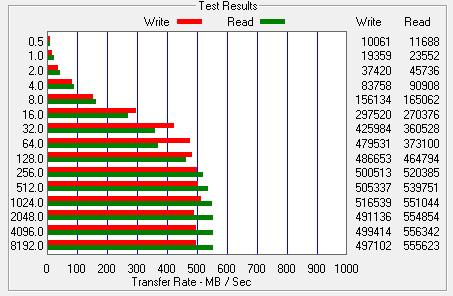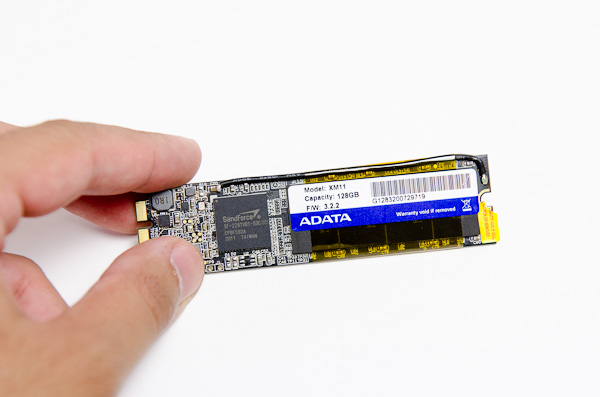ASUS Zenbook (UX21) Review
by Anand Lal Shimpi on October 22, 2011 8:00 PM ESTTwo SSD Options: SandForce and SanDisk
Like many OEMs, ASUS sources SSDs from two vendors for its Zenbook line: ADATA and SanDisk. Unlike Apple however, the division isn't random. ADATA supplies all 128GB drives while SanDisk handles the 256GB drives. The explanation is simple: ASUS needed a drive that could fit all of its NAND on a single side. SanDisk had a 256GB offering that met those needs; ADATA/SandForce did not.
ASUS didn't specify what SanDisk controller was in use on the 256GB drives, but I suspect it's the U100. ASUS supplied the following test data comparing the two SSDs:

Performance is actually comparable between the two, which is surprising. I'm going to see about getting my hands on a 256GB SanDisk model for comparison to verify for myself. The sample laptop we received comes with the 128GB ADATA drive, which performed quite well in our tests:

Granted you're looking at highly compressible datasets, but being able to break 500MB/s puts this drive up there with the standard desktop SF-2281 offerings.
If you caught our Zenbook teardown you may have noticed a firmware label on the ADATA drive indicating it was using SandForce firmware revision 3.2.2. Uhoh! SandForce just recently announced that there is a known bug in all version of the SF-2281 firmware prior to 3.3.2 that can cause BSODs. I asked ASUS when we'd see an updated firmware and why on earth it chose to ship a drive with a widely known bug.
During development, ASUS tested 100+ Zenbooks with 100+ samples of the ADATA drive. The testing included over 50,000 accumulated reliability tests including rapid sleep/wake cycles, 3DMark and other application based tests. In addition to pre-production testing, ASUS conducted additional testing on mass production units. Throughout this entire process ASUS didn't see any reliability issues with the SandForce drives and thus felt comfortable shipping with them. I should add that we have seen many cases where the SF BSOD bug simply won't appear on certain platforms, lending credibility to ASUS' claims that the SandForce drives proved stable during testing.
That being said, I'd still feel more comfortable with an upgrade to 3.3.2 if it turns out that this firmware revision does in fact fix a known issue with the drive.
I pointed out the obvious rework on the ADATA SSD to ASUS engineering. The team responded by saying the rework was implemented to reduce EMI, which was a bit too close to the margins before the change. The rework has since been incorporated into a surface mount component design which will ship in a future spin of the drive. I'm not a huge fan of reworks on shipping products but from time to time they do appear. The nature of the rework and quality of the workmanship are also important to keep in mind, both of which are less alarming in this case than others.











109 Comments
View All Comments
KPOM - Sunday, October 23, 2011 - link
Nice review, as usual. The ASUS Zenbooks are the first credible competitors to the MacBook Air, in my opinion (far more than the Acer), in that they are nearly identically equipped, with some upgrades (faster SSD, better sound) at a lower price. Hopefully this pushes Apple a bit to do some upgrades for next year's Ivy Bridge MacBook Air (I wouldn't mind a better speaker and 6Gbps SSDs, and perhaps a small price drop for the upgraded models).C300fans - Monday, October 24, 2011 - link
I fail to see any lower price comparing with AIR.madmark4 - Thursday, November 3, 2011 - link
Seriously?Let me step you through it then:
1) Base MBA, $999. Slower processor, 64gb SSD, and 2gb ram.
2) Base UX21, $999. Faster processor, 128gb SSD, and 4gb ram.
Did you happen to see the lower prices there? I think most do.
sapi3n - Sunday, October 23, 2011 - link
my problem with this piece of hardware is in the interface. I've got a core 2 duo Asus laptop that is quite good, but the keyboard is like typing on a rope bridge, forcing me to carry an external keyboard for anything expansive. I wish this wonderful company would start with the keyboard, and work outward.twotwotwo - Sunday, October 23, 2011 - link
Sounds like you find the bad display contrast pretty maddening. Are you saying you'd advocate Windows users get a Macbook Air just because of it, though? It's $250 more (system cost + getting Windows Home Premium) plus the fuss of setting up Boot Camp, and folks might prefer the Zenbook for the better SSD, the resolution, the USB 3/VGA/HDMI/Ethernet connection options, etc. The Air seems like a choice for graphics-focused folks or people looking for *the* most premium ultraportable there is, but it doesn't seem like the shoo-in choice for a typical mobility-focused Windows user.But if the display *is* a total dealbreaker I'd love to hear more about why. A dull grey backlight bleed sounds annoying, but reflections from a glossy screen coating seem worse to me and reviewers seem to mostly accept the trend towards glossy displays. But I can't really do any comparisons since I don't have a Zenbook sitting around (or a ThinkPad X1, which seems to have the same contrast level), so your insight would be interesting here.
Does sound like a pity about the Asus's touchpad. :/
agent2099 - Sunday, October 23, 2011 - link
I'm disappointed with the maximum resolution for the microHDMI port. It only does 1900x1080 which means you cannot connect it ton a 24" monitor at native res (1900x1200). Is this just a limitation of the microHDMI port or for all intel HD graphics. For some of the other laptops out there that have full size HDMI, can you output 1900x1200 native?repoman27 - Monday, October 24, 2011 - link
The HD Graphics in 2nd Gen Intel Core processors support HDMI 1.4 features, one such feature being the Micro HDMI connector itself. Intel is a bit vague as to the maximum resolution using HDMI, although they clearly note that 2560x1600 is achievable using DisplayPort 1.1. It's odd that the spec here is for less than 1920x1200 since even HDMI 1.0 supported resolutions that high. Although 1920x1200 displays seem to be going the way of the dodo due to the onslaught of 1920x1080 "Full-HD" panels, it's still curious to see such a seemingly arbitrary limitation.Watwatwat - Monday, October 24, 2011 - link
if you are just using this anywhere, on your lap even, viewing angle becomes key, esp with such a small short display. they really dropped the ball going brighter instead of wider.rs2 - Monday, October 24, 2011 - link
Sorry, but you must be dreaming. Either that, or your requirements for labeling something "extremely responsive" have seriously been slipping. Extremely responsive doesn't mean "static content scrolls smoothly across the screen and looks pretty", it means more along the lines of "when I launch an app, I don't have to wait 5 to 10 seconds for it to load and become usable" and "I can switch easily and quickly between multiple applications, without losing my view of any of them if I so choose" and "my device doesn't need a full minute to power on from a cold start".Today's tablets are a world away from being "extremely responsive" by any reasonable set of criteria.
alxx - Monday, October 24, 2011 - link
So any chance of giving this a review with it running linux ?fedora 15 or ubuntu ?
Is it full bluetooth 4 support or limited ?
Does it support HS , low power and low energy or ???